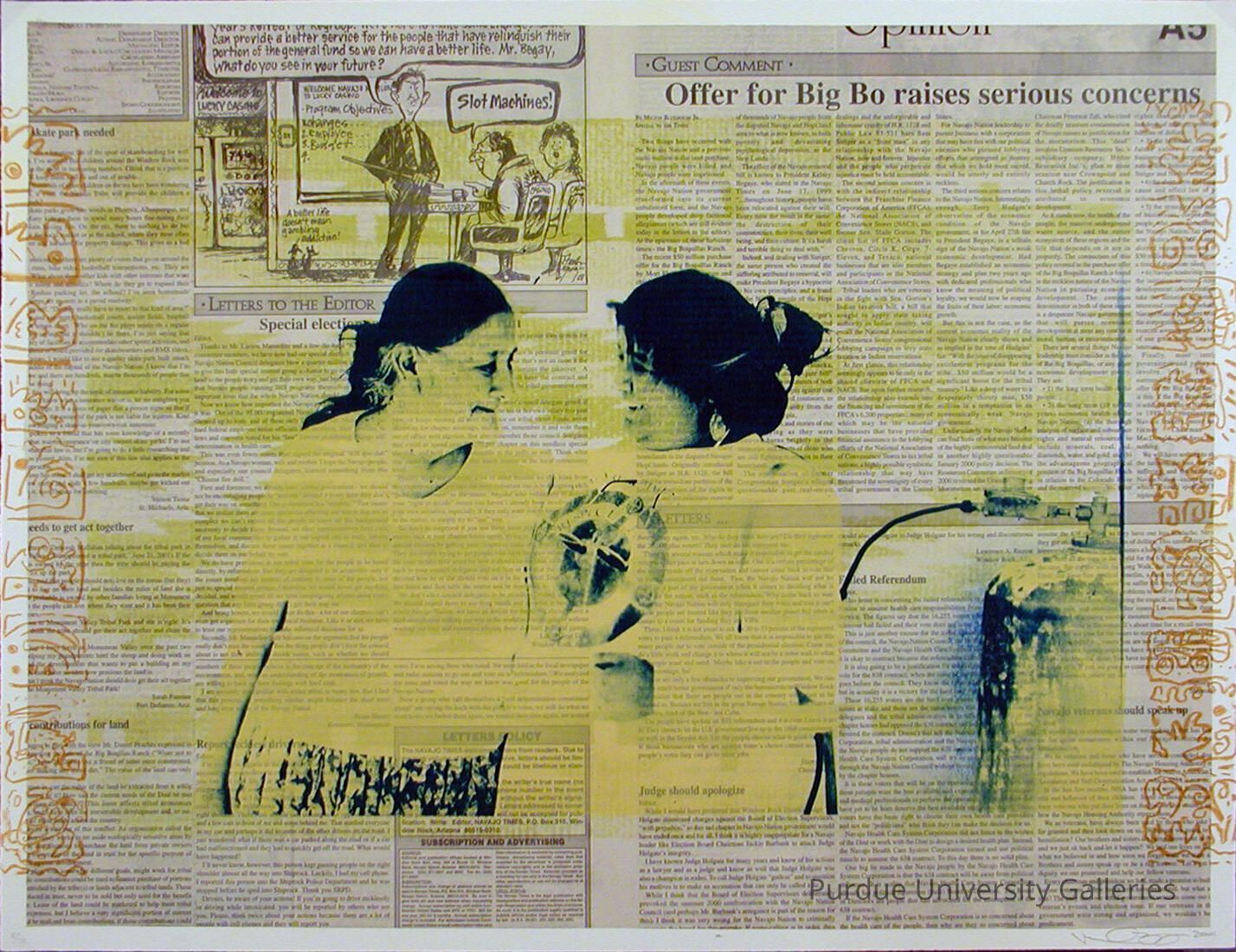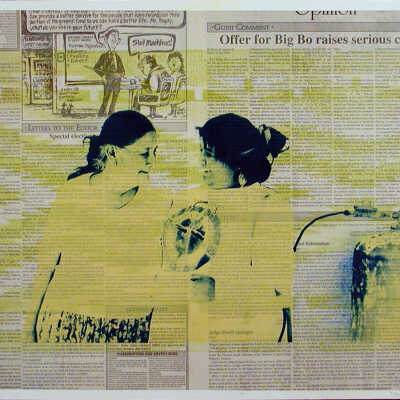Label Type
Cultural/Historical ContextLabel
Thelma and Me
Melanie Yazzie (b. 1966)
Five Color Lithograph, Chine Collé Navajo Times, 2001
Melanie Yazzie is a printmaker, sculptor, painter, and multimedia artist living and working in Colorado. Her work explores the role of women in Diné (Navajo) culture, memories from her childhood growing up on the Navajo Reservation, and seeks to educate the world at large about contemporary indigenous peoples and the post-colonial issues they face. She blends contemporary and traditional Native American imagery as well as themes of travel and transformation. Yazzie is a professor and the head of printmaking at the University of Colorado, Boulder and has exhibited her work throughout the United States and abroad.
The print is about my relationship with my grandmother, Thelma Baldwin. She was my mother's mother and when I was little I stayed with my mother‘s parents a lot. Her husband's name is Tom Baldwin. They were like parents to me as I grew up.
I wanted to show just show how beautiful she is. She and my grandfather have passed away in the past ten years. The sadness and pain from it is still present. It was very difficult for me. I miss them so very much.
I am really glad that I made this print because I feel it honors her and shows the love we have for each other. I have another print that has my grandfather in it. I often reflect on my time with them in my childhood and those times are reflected in many of my art pieces.
Melanie Yazzie, ArtistLabel Type
Cultural/Historical ContextLabel
"Melanie Yazzie is a member of the Navajo tribe who grew up on the Navajo reservation in Arizona. She belongs to the Salt and Bitter Water clans of the Diné people, a Navajo group. Yazzie has a B.A. in studio art and Spanish from Arizona State University and an M.A. in printmaking from the University of Colorado. Yazzie is greatly influenced by the oral histories and stories of the Diné and Navajo, and she often uses creation imagery in her art. She works in a variety of media including painting, printmaking, and sculpture. Yazzie strives to present ideas of her culture and her people without idealizing or commercializing them. Socially, Yazzie focuses on the colonization of indigenous peoples throughout the world, and on personal and national identities. She often collaborates with artists in other nations such as New Zealand, Russia, Australia, Canada, Mexico, Germany, and Japan.
Thelma and Me contains a photograph of two women, presumably Navajo, superimposed on an issue of the Navajo Times. The newspaper articles feature modern concerns of the Navajo such as fighting stereotypes and the selling of land. The women shown are linked to some type of basket that resembles a traditional Native American vessel. On both sides of the print are stamps that appear to be Native American icons and figures of presumably Navajo or even specifically Diné origin, since that is generally Yazzie’s focus.
The artist likes to blend traditional and contemporary Native American themes and to focus on the repercussions of colonization. Yazzie also often combines both aggressive and lighthearted references to emphasize her message. Thelma and Me combines the modern Navajo newspaper with its current issues while also featuring a photograph of modern Navajo. It seems lighthearted because it depicts the two women smiling, and the colors used are pleasant. The newspaper articles, however, give it a harsher message. They reflect problems that the Navajo have had for centuries and the symbols also refer to tribal traditions. Printmaking is a common medium for Yazzie, and she often uses mixed media in her works.
Bibliography: Warner 2007: 18-22; Bill, Amber. “35 Years at the C.N. Gorman Museum: Artist Bios.” gormanmuseum.ucdavis.edu (accessed Apr. 4, 2011). “Western Carolina University: Prints of the Fine Art Museum.” www.wcu. edu (accessed Apr. 4, 2011).
Submitted by Rebekah Williamson
--
Melanie Yazzie’s work often combines images of printed media -- sometimes postcards, tourist souvenirs, or, in this case, a Navajo newspaper -- with photographs of her family and members of her community. These combinations reinforce the image of Navajo people as a real, thriving community of individuals rather than as a romantic, vanished race."
